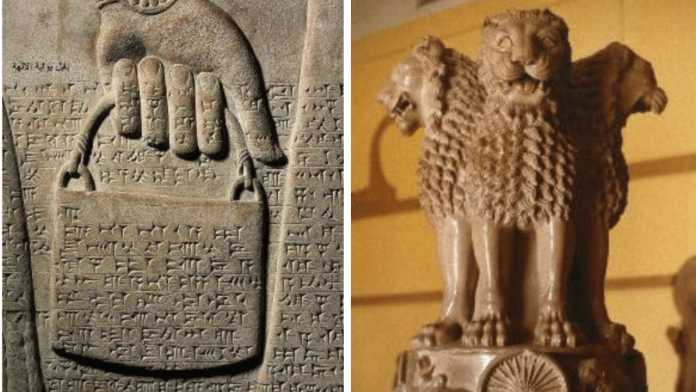Thank you dear subscribers, we are overwhelmed with your response.
Your Turn is a unique section from ThePrint featuring points of view from its subscribers. If you are a subscriber, have a point of view, please send it to us. If not, do subscribe here: https://theprint.in/
As in everything in life that has a history, there’s often a story behind the story!
Symbols in artifacts, languages, and the stories that shape our collective thinking!
As I reflect on my life’s journey, I see a profound tapestry of historical connections between India and Persia, which my father mentioned to me as a youngster at the time, that we are descendants from Persia. This exploration has revealed an enduring legacy of religious tolerance, cultural exchanges, and shared symbols across civilizations. Beneath the surface of apparent differences lies an interconnected human story, where history’s threads unite us far more than they divide us.
The Mitanni Kingdom, a powerful Bronze Age empire (1500–1360 BCE), exemplifies this connection. Its kings bore Sanskrit-derived names like Tushratta and Artatama, while their pantheon of gods—Indra, Varuna, Mitra, and Nasatya—aligns with Hindu Vedic deities. The name Mitanni itself stems from the Sanskrit word metta, meaning “united.” This reflects not only linguistic roots but also a shared spiritual and cultural heritage between India and Mesopotamia. This revelation bridged what I once perceived as a divide between my father’s comments on our Indian and Persian ancestry. In reality, these cultures share a unified history that transcends man-made borders.
Guru Nanak’s Baghdad: Bridging Spiritual Realms
This historical unity finds a modern parallel in the travels of Guru Nanak, the founder of Sikhism. Born a Hindu, Guru Nanak transcended religious divides and embarked on global travels known as Udasis. During his second Udasi, Guru Nanak reached Baghdad, where he engaged in a discourse with Pir Bahlol, a prominent Sufi saint. Their conversation focused on the omnipresence of the Divine, highlighting that religious differences are merely superficial. A shrine in Baghdad commemorates this meeting, symbolizing how dialogue between cultures and faiths can create unity and understanding.
The Sikh Empire under Maharaja Ranjit Singh further underscored this legacy of tolerance. During the Empire’s peak, it provided refuge to Persian Jewish exiles escaping persecution. This act reflected Sikhism’s core principle—recognizing humanity as one family. These exiled communities, carrying linguistic influences from India, contributed to the development of the Romani language in Europe. A fascinating example of syncretism lies in the Romani word Trishul, which refers to the Christian cross—underscoring the cultural evolution and interplay between symbols across civilizations.
Symbols: The Universal Language of Humanity
Throughout my journey, I have been fascinated by the interconnected symbolism of religions. The Trishul, Khanda, and Christian Cross serve as examples of shared themes across diverse traditions.
- The Trishul, representing Lord Shiva’s trident in Hinduism, symbolizes the triad of creation, preservation, and destruction.
- The Khanda, Sikhism’s central emblem, represents divine knowledge (double-edged sword), unity (circle), and spiritual-temporal balance (two single-edged swords).
- The Christian Cross, representing Christ’s crucifixion, conveys sacrifice, redemption, and hope.
Though originating in distinct traditions, these symbols reflect humanity’s shared yearning for divine connection, moral order, and balance. The adoption of Trishul to represent the Christian cross in Romani culture exemplifies this cross-pollination of ideas across geographic and cultural boundaries.
Another symbol that captivated me is the eight-spoked wheel. A stone bas-relief from Nimrud, Iraq, depicts a wheel strikingly similar to Ashoka’s Chakra, representing the Dharmachakra in Indian tradition. Across ancient civilizations, the wheel often symbolized cosmic order, divine law, and the cyclical nature of life—evidence of universal themes emerging independently yet resonating across cultures.
The Vedic Roots of Persia and the Mitanni Influence
Persia’s ties to Vedic India go beyond symbols and language. The Persepolis Fortification Tablets, unearthed in 1933, revealed striking linguistic parallels between ancient Persian and Sanskrit. Names such as Cyrus (similar to the Sanskrit Kuru) reflect this shared heritage, suggesting that Vedic Indians may have migrated westward, influencing Persian culture and language.
The Mitanni, as torchbearers of Vedic tradition, represent a forgotten chapter in history. Settling in Mesopotamia and Anatolia, they carried with them Indo-Aryan religious and linguistic elements, evident in their worship of Vedic deities. This Indo-Aryan influence may have shaped the early Persian and Mesopotamian civilizations, creating a foundation upon which the Achaemenid Empire later thrived.
Adding further intrigue, both Vedic and Persian traditions share a deep reverence for fire as a sacred element, symbolizing purity and divine energy. The Zoroastrian fire temples of Persia mirror similar Vedic practices in India, suggesting a shared cultural origin or mutual exchange.
A Forgotten Chapter: Rethinking the Out of India Theory
The Out of India Theory challenges conventional views on Indo-Aryan migrations. It posits that Vedic Indians migrated westward, influencing civilizations in Persia, Anatolia, and beyond. If true, this theory offers a plausible explanation for the cultural, linguistic, and religious overlaps between India, Persia, and even Europe.
The shared linguistic roots, architectural parallels, and symbols—such as the Dharmachakra and eight-spoked wheel—reinforce the idea that ancient Indians were not isolated but actively contributed to the global exchange of ideas.
Conclusion: Honoring a Shared Heritage
My journey of discovery has transformed my understanding of identity, culture, and history. The stories of the Mitanni, the shared symbols of humanity, and the teachings of Guru Nanak reveal an interconnected past where cultures enriched one another rather than existing in isolation.
The ancient ties between India and Persia—and their echoes in Mesopotamia and beyond—remind us that history is not a linear narrative of separation but a rich tapestry of interconnected threads. From the Trishul to the Cross, from Sanskrit to Persian, these connections challenge us to celebrate our shared heritage and recognize that, like the stars in space, our divisions are man-made, but our unity is timeless.
These pieces are being published as they have been received – they have not been edited/fact-checked by ThePrint.


